Meteoroids, Meteors, and Meteorites
As noted earlier, asteroids occasionally collide with each other, sending fragments into interplanetary space. These smaller pieces, along with rocky and metallic debris from evaporating comets, and material that never coalesced with larger bodies, are still orbiting the Sun. Meteoroids are rocky and metallic debris smaller than asteroids that are scattered throughout the solar system. Although no official size standard distinguishes the two, meteoroids are no more than about 10 m across, and the vast majority of them are smaller than 1 mm. Meteors are meteoroids that are being vaporized in the atmosphere. Meteorites are remnants of meteoroids that land intact.
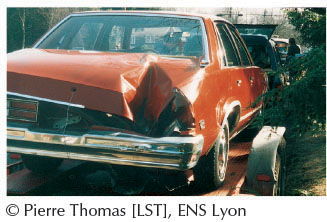
By studying the chemistry of various asteroids, astronomers are now beginning to identify which ones were the origins for other asteroids and for meteoroids. For example, the asteroid Braille (named in honor of Louis Braille, 1809–1852, developer of the alphabet for the blind) is a piece of debris 2 km long that was blasted off the 500-km-diameter asteroid Vesta.
9-10 Small, rocky debris peppers the solar system
 Passing meteoroids are often pulled by gravity toward Earth. As they move through our atmosphere, they compress and heat the gases in front of them so much that the surrounding air glows. The glowing gas, accompanied by vaporized pieces of the infalling matter, creates the trail we see, and the meteoroid becomes a meteor (Figure 9-36a). Common names for these dramatic streaks of light flashing across the sky include shooting stars, fireballs, and bolides. Fireballs are meteors at least as bright as Venus; bolides are bright meteors that explode in the air. Therefore, “shooting stars” are not stars of any kind or dying stars.
Passing meteoroids are often pulled by gravity toward Earth. As they move through our atmosphere, they compress and heat the gases in front of them so much that the surrounding air glows. The glowing gas, accompanied by vaporized pieces of the infalling matter, creates the trail we see, and the meteoroid becomes a meteor (Figure 9-36a). Common names for these dramatic streaks of light flashing across the sky include shooting stars, fireballs, and bolides. Fireballs are meteors at least as bright as Venus; bolides are bright meteors that explode in the air. Therefore, “shooting stars” are not stars of any kind or dying stars.
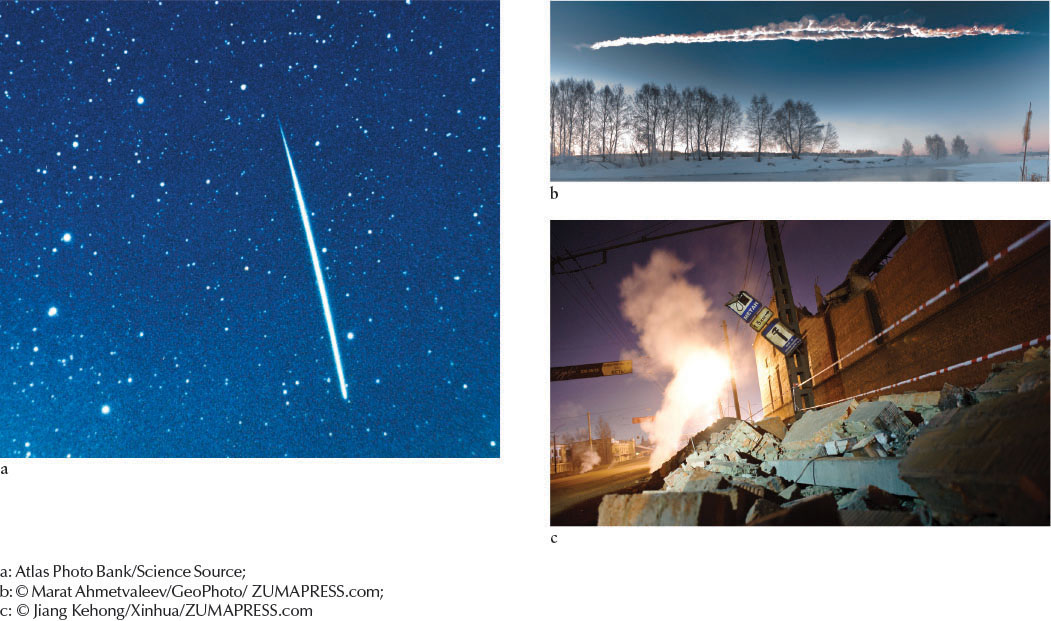
298
As mentioned in Section 9-5, a spectacular bolide estimated to have been 17–20 m (57–66 ft) across was seen passing Chelyabinsk, Russia, on February 15, 2013 (Figure 9-36b). Moving faster than the speed of sound, the sonic boom it created broke innumerable windows. Flying glass injured about a thousand people. The bolide then exploded at an altitude of about 32 km (20 mi) above nearby Lake Cherbarkul. Had it exploded over the city, the debris that rained down would likely have killed people. As it happened, no one was killed in the event.
One hundred and five years before the meteoritic event in Chelyabinsk, at 7:14 a.m. local time on June 30, 1908, a much more spectacular explosion occurred over Russia, this one over the Tunguska region of Siberia. The blast, comparable to a nuclear detonation of several megatons, knocked a man off his porch some 60 km away and was audible at a distance of more than 1000 km. Millions of tons of dust were injected into the atmosphere, darkening the air as far away as California.
Preoccupied with wars, along with political and economic upheaval, neither Russia nor its successor, the Soviet Union, sent a scientific expedition to the site until 1927. At that time, Soviet researchers found that trees had been seared and felled radially outward in an area about 30 km in diameter (Figure 9-37). There was no clear evidence of a crater. In fact, the trees at “ground zero” were left standing upright, although they were completely stripped of branches and leaves. Because no significant meteorite samples were found, for many years scientists assumed that a small comet had exploded in the atmosphere.
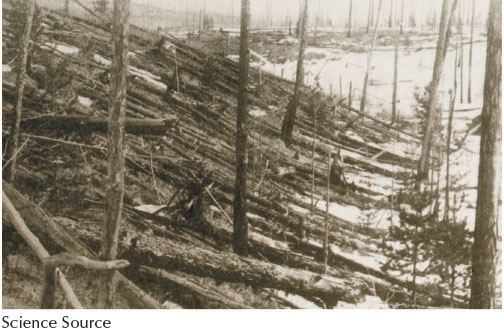
Recently, however, several teams of astronomers have argued that a small comet, composed of primarily light elements and ice, would break up too high above the ground to cause significant damage. They argue that the Tunguska explosion was actually caused by a small asteroid or large meteoroid traveling at supersonic speed. The Tunguska event is consistent with an explosion of an asteroid about 80 m (260 ft) in diameter entering Earth’s atmosphere at a shallow angle, moving at 79,000 km/h (50,000 mi/h) and exploding in the air as a result of becoming exceedingly hot. The resulting shock wave, slamming into the ground, would cause the damage seen without creating a crater. The debate on the cause of the Tunguska event continues.
Most meteors vaporize completely before they can strike Earth. Their dust settles to the ground, often carried by raindrops. (This dust is not the source of acid rain, however, which comes from natural and human-made gases ejected into the atmosphere.) Pieces of a meteor that survive the fiery descent to Earth may leave an impact crater. Weather and water erosion are wearing away all of the nearly 200 known impact craters on Earth and thousands more have long since been drawn into Earth by the motion of Earth’s tectonic plates. Indeed, the craters that exist today are all less than 500 million years old because of forces reshaping Earth’s surface.
One of Earth’s least-weathered impact craters is Meteor (or Barringer) Crater near Winslow, Arizona (Figure 9-38). Measuring 1.2 km across and 200 m deep, it formed approximately 50,000 years ago when an iron-rich meteoroid some 50 m across (about half the length of a football field) struck the ground at 40,000 km/h (25,000 mi/h). The blast was like the detonation of a 20-megaton hydrogen bomb.
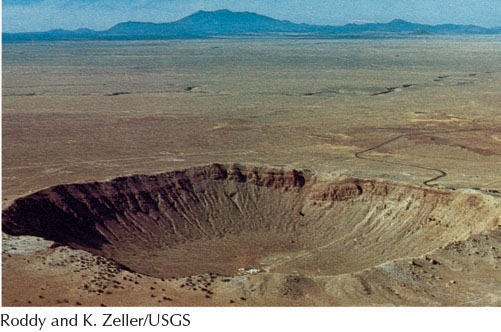
299
On a typical clear night, you can expect to see a meteor about every 10 minutes. However, at predictable times throughout each year, Earth is inundated with them. These meteor showers occur when Earth passes through the orbit of debris left behind by a comet (Figure 9-39 and Figure 9-40; also see Figure 9-32).
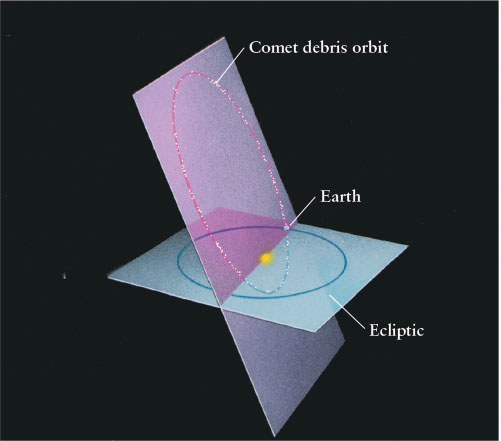
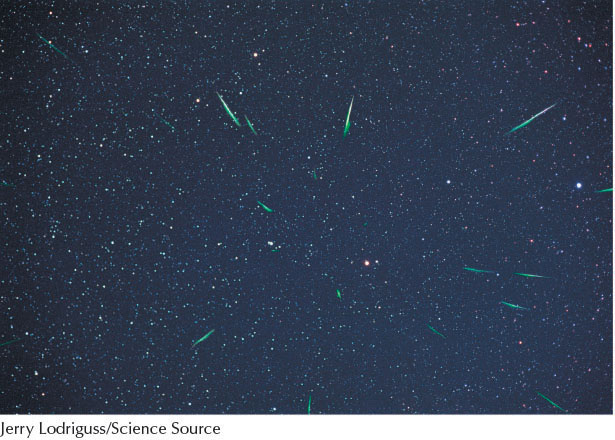
Some 30 meteor showers can be seen each year (see Table 9-1). Because the meteors in each shower appear to come from a fixed region of the sky, they are named after the constellation from which the meteors appear to radiate (Figure 9-40). For example, meteors in the Leonid shower appear to originate in the constellation Leo Major. More than one meteor can be seen each minute at the peaks of such prodigious meteor showers as the Perseids. These events are among the most exciting light shows in astronomy. Except for the Lyrids, meteor showers are best seen after midnight.
| Shower | Date of maximum intensity | Typical hourly rate | Constellation |
|---|---|---|---|
| Quadrantids | January 3 | 40 | Boötes |
| Lyrids | April 22 | 15 | Lyra |
| Eta Aquarids | May 4 | 20 | Aquarius |
| Delta Aquarids | July 30 | 20 | Aquarius |
| Perseids | August 12 | 80 | Perseus |
| Orionids | October 21 | 20 | Orion |
| Taurids | November 4 | 15 | Taurus |
| Leonids | November 16 | 15 | Leo Major |
| Geminids | December 13 | 50 | Gemini |
| Ursids | December 22 | 15 | Ursa Minor |
Margin Question 9-8
Question
Why are the times when meteor showers occur so predictable?
The Moon also moves through the debris that creates meteor showers on Earth. Whereas our atmosphere vaporizes most of the meteors before they strike Earth, the Moon’s thin atmosphere provides no protection, so the Moon is struck by numerous meteoroids during each shower. The Leonid meteor shower of 1999 provided astronomers with an excellent opportunity to observe contemporary impacts on the Moon (see Figure 9-41). Some of these impacts were even bright enough to see with the naked eye. When a 10-kg meteorite strikes the Moon, the impact is as powerful as 104 pounds of TNT, and the resulting cloud is momentarily between 5 × 104 and 10 × 104 K, which is hotter than the surface of the Sun. Other meteor showers have provided further impact sightings on the Moon.
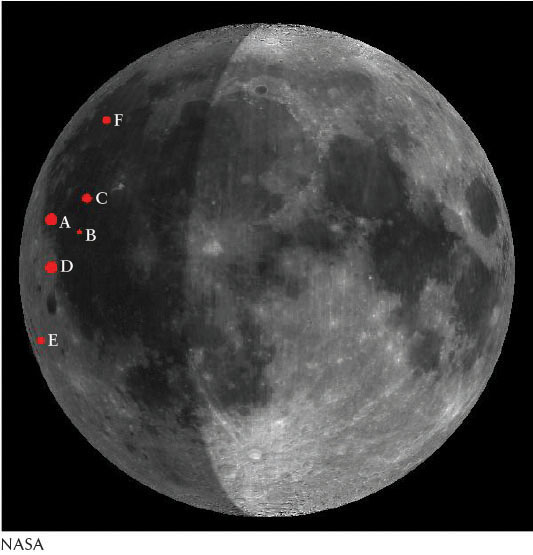
300
9-11 Meteorites are space debris that land intact
Although most meteors that enter Earth’s atmosphere completely vaporize or are destroyed on impact, some land without totally disintegrating. Such pieces of debris are called meteorites, and they come from a variety of sources. By studying their chemistries and comparing them to the chemistries of planets, moons, asteroids, and comets, we know that many meteorites were ejected from these bodies by collisions (Figure 9-42). We saw in Section 7-12, for example, how SNC meteorites offer clues to the chemistry of Mars. By studying the chemistry and age of one meteorite from the Moon that was found on Earth, geologists have determined that it was ejected into space when the Mare Imbrium impact basin formed. Meteorites from the asteroid Vesta show signs of having been molten rock on that world. They were ejected when an impact occurred there, creating a crater 460 km (280 mi) wide and 13 km (8 mi) deep, which has been seen by the Hubble Space Telescope. The spectra also reveal that some meteorites are debris that was never part of larger bodies.
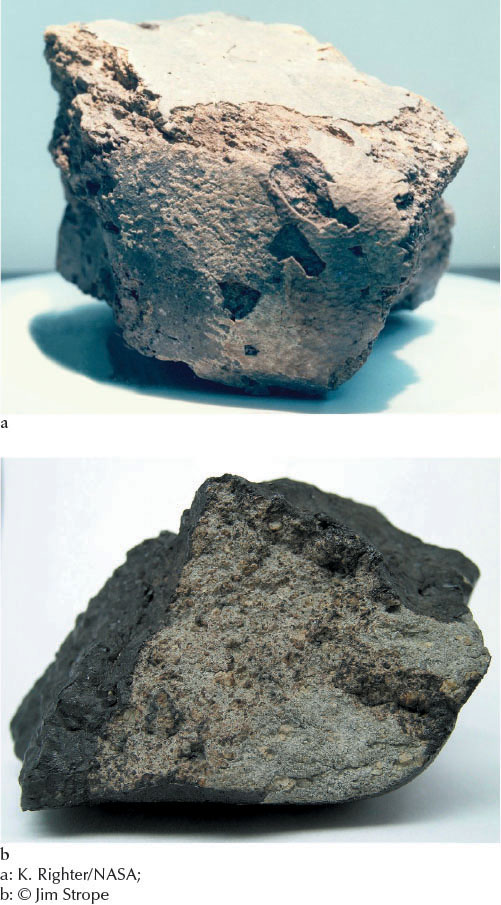
Meteorites tell us the age of the solar system. Measuring the relative amounts of various radioactive elements in them allows astronomers to determine how long ago they formed (see An Astronomer’s Toolbox 4-2: Radioactivity and the Ages of Objects). The oldest known meteorites became solid bodies about 4.57 billion years ago, and impacts on Earth as early as 4 billion years ago have been identified, based on how they disturbed preexisting rock here. Therefore, the solar system is at least 4.57 billion years old, and we will use 4.6 billion years as its age throughout the book.
People have been picking up debris from space for thousands of years. The descriptions of meteorites in historical Chinese, Indian, Islamic, Greek, and Roman literature show that early peoples placed special significance on these “rocks from heaven.” Meteorites also have a practical “impact”: Infalling space debris is increasing Earth’s mass by nearly 300 tons per day on average (Figure 9-43).

301
Stony Meteorites Often Look like Ordinary Rocks
Meteorites are classified as stones (or stony), stony-irons, and irons. Most stony meteorites look much like ordinary rocks, although some are covered with a dark fusion crust (Figure 9-44a), created when the meteorite’s outer layer melts during its fiery descent through the atmosphere (see Figure 9-40). When a stony meteorite is cut in two and polished, tiny flecks of iron are sometimes found in the rock (Figure 9-44b).
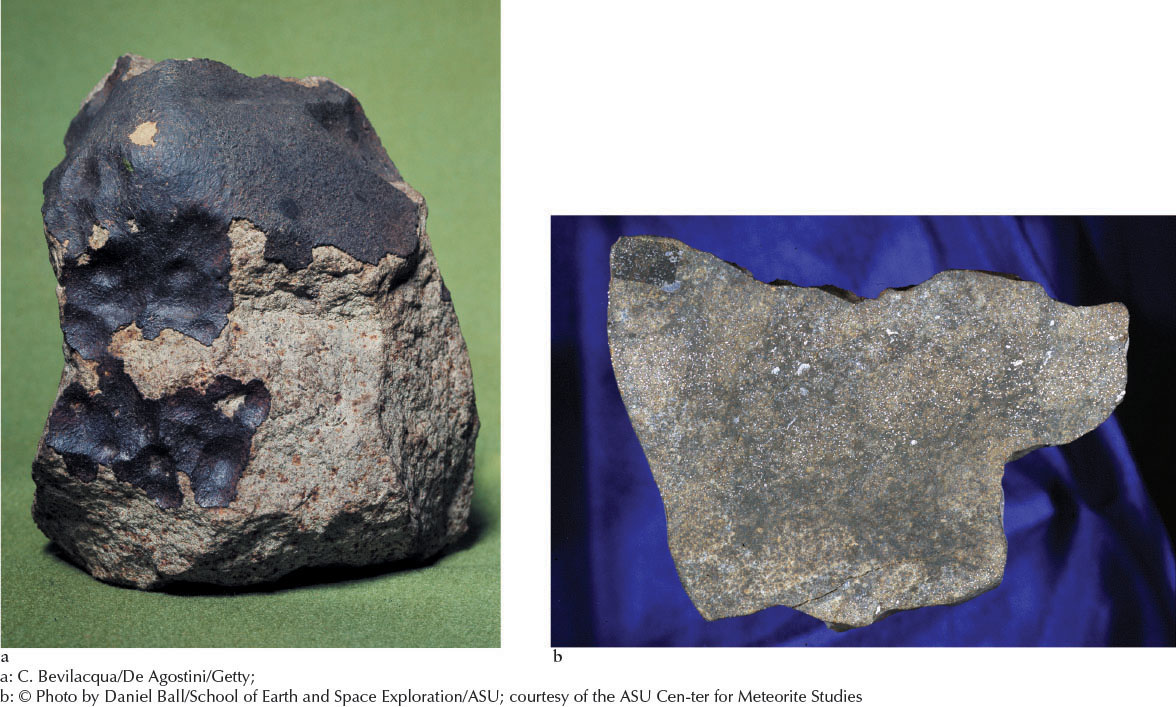
Iron Meteorites Are Very Dense and Look Noticeably Different from Rocks
Iron meteorites (Figure 9-45) may also contain from 10% to 20% nickel by weight. Iron is moderately abundant in the universe as well as being one of the most common rock-forming elements, so it is not surprising that iron is an important constituent of asteroids and meteoroids. Another element, iridium, is common in the iron-rich minerals of meteorites but rare in ordinary rocks on Earth’s surface. Iridium binds strongly to iron, so when Earth was first forming and iron was descending into our planet’s core, it carried down most of the iridium that was associated with it. Measurements of iridium in Earth’s crust can thus tell us the rate at which meteoritic material has been deposited over the ages.

Meteorites with a high iron content can be located with a metal detector. They also look unusual and hence are more likely to be noticed. Consequently, the easily found iron and stony-iron meteorites dominate most museum collections. In 1808, Count Alois von Widmanstätten (1753–1849), director of the Imperial Porcelain Works in Vienna, discovered a conclusive test for the most common type of iron meteorite. Most iron meteorites have a unique structure of long nickel-iron crystals, called Widmanstätten patterns, which become visible when the meteorites are cut, polished, and briefly dipped into a dilute solution of acid (Figure 9-45b). Because nickel-iron crystals can grow to lengths of several centimeters only if the molten metal cools slowly over many millions of years, Widmanstätten patterns are never found in counterfeit meteorites (or “meteorwrongs”).
302
Stony-Iron Meteorites Are the Most Exotic of All Space Debris on Earth
The final category of meteorites are the stony-iron meteorites, which consist of roughly equal amounts of rock and iron. Figure 9-46, for example, shows the mineral olivine suspended in a matrix of iron.
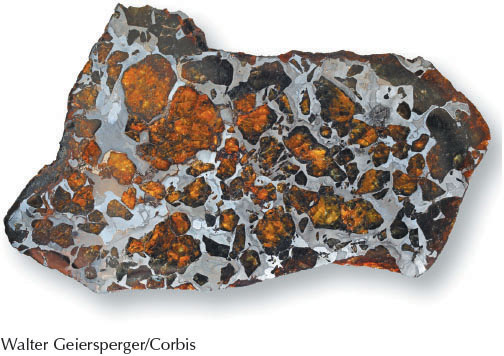
To understand why different types of meteorites exist, we consider their formation. Many meteorites were once pieces of asteroids. Heat from impacts and from the rapid decay of radioactive isotopes melted newly formed asteroid interiors. Over a few million years after they formed, differentiation occurred, just as in young Earth. Iron sank toward the asteroid’s center, while lighter rock floated up to its surface. Iron meteorites are fragments of asteroid cores, and stony-irons come from the boundary regions between the iron cores and stony crusts.
Margin Question 9-9
Question
Why are stony-iron meteorites so rare compared to stony or iron meteorites?
Stony meteorites have a variety of origins. Some come from the outer layers of asteroids. Other stony meteorites, ordinary chondrites, show no evidence of ever having been melted as parts of asteroids. They may therefore be primordial material from which our solar system was created. Carbonaceous chondrites are rare chondrites that contain small glass-rich beads called chondrules. These meteorites also contain complex carbon compounds, including simple sugars and glycerin. They also have as much as 20% water bound into their minerals. The organic compounds would have been broken down and the water driven out if these meteorites had been significantly heated as during large asteroid formation. The small, undifferentiated asteroid Mathilde, shown in Figure 9-17a, has a very dark gray color and virtually the same spectrum as a carbonaceous chondrite meteorite, so it is also likely composed of this primordial material.
Amino acids are among the organic compounds occasionally found inside carbonaceous chondrites. By observing their spectra, we know that organic compounds exist on asteroids and smaller space debris. Indeed, some scientists suspect that amino acid–rich carbonaceous chondrites may have played a role in the origin of life on Earth.
303
Not All Meteorite Impacts (“Falls”) Lead to Meteorite “Finds”
Stony meteorites account for about 94% of all meteoritic material that falls on Earth. Most stony meteorites are overlooked because they look like ordinary stones. Indeed, the percentages of the stony, iron, and stony-iron meteorites that are discovered, called finds, are quite different from the percentages that actually land, called falls. Nevertheless, astronomers and geologists have a good idea about how many of each type strike land. They obtain the correct percentages of impacts by carefully surveying areas in which only meteorites land, namely snow and ice-covered regions, such as Antarctica, or on deserts. By counting all of the debris under the surface using metal detectors and other technologies, the actual number of impacts of each type of meteorite is determined. Table 9-2 lists the relationship between the falls and finds.
| Stony | Iron | Stony-Iron | |
|---|---|---|---|
| Falls | 94% | 4.8% | 1.2% |
| Finds | 53% | 42% | 5% |
9-12 The Allende meteorite provides evidence of catastrophic explosions
A chance to study debris immediately after a meteorite impact came shortly after midnight on February 8, 1969, when a brilliant, blue-white light shot across the night sky over Chihuahua, Mexico. Hundreds of people witnessed the dazzling display. The light disappeared in a spectacular and deafening explosion that dropped thousands of rocks and pebbles over the terrified onlookers. Within hours, teams of scientists were on their way to collect specimens of carbonaceous chondrites, collectively named the Allende meteorite, after the locality in which they fell (Figure 9-47).

One of the most significant discoveries to come from the Allende meteorite was evidence of the detonation of a nearby supernova 4.6 billion years ago (see Section 5-2). Among nature’s most violent and spectacular phenomena, a supernova explosion occurs when a massive star blows apart in a cataclysm that hurls matter outward at tremendous speeds, as we will explore in Chapter 13. During this detonation, violent collisions between atomic nuclei produce a host of radioactive elements, including a short-lived radio-active isotope of aluminum. Based on its decay products, scientists found unmistakable evidence that this isotope once lay within the Allende meteorite. Some astronomers interpret this as evidence for a supernova in our vicinity at about the time the Sun was born. By compressing interstellar gas and dust, the supernova’s shock wave may have helped stimulate the birth of our solar system.
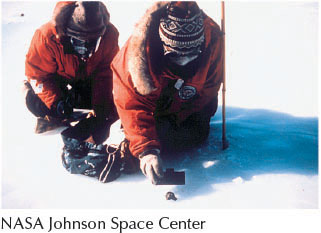
304
9-13 Asteroid impacts with Earth have caused mass extinctions
In the late 1970s, the geologist Walter Alvarez (b. 1940) and his father, physicist Luis Alvarez (1911–1988), discovered the remnants of a truly Earth-shaking impact. Working at a site of exposed marine limestone in the Apennine Mountains in Italy that had been on Earth’s surface 65 million years ago, the Alvarez team discovered an exceptionally high abundance of iridium in a dark-colored layer of clay between limestone strata (Figure 9-48). Recall from above that the iridium that was present on the surface when Earth differentiated sank to the core. The iridium found by the Alvarez team had to have been deposited much later.
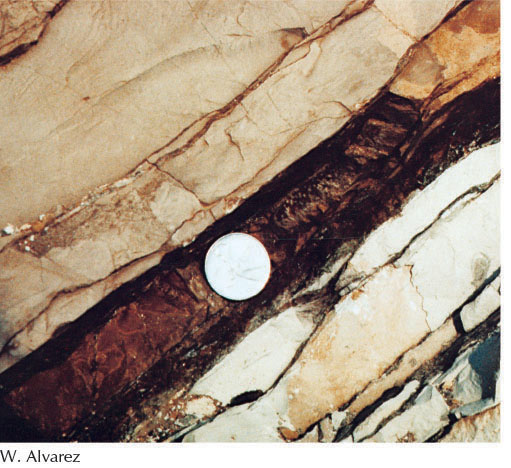
Margin Question 9-10
Question
What evidence do astronomers have from the Allende meteorite that a supernova explosion occurred at about the time the solar system formed?
Since 1979, when this discovery was announced, a comparable layer of iridium-rich material has been uncovered at numerous sites around the world. In every case, geologic dating reveals that this apparently worldwide iridium-rich layer was deposited about 65 million years ago. Paleontologists were quick to realize the significance of this date, because it was back then that all of the dinosaurs rather suddenly became extinct. In fact, two-thirds of all animal species disappeared within a brief span of time 65 million years ago.
 The Alvarez discovery supported an astronomical explanation for the dramatic extinction of so much of the life that once inhabited our planet—an asteroid impact. There is no universal agreement on the disasters that befell Earth during this episode. One scenario has an asteroid 10 km in diameter slamming into Earth at high speed and throwing enough dust into the atmosphere to block out sunlight for several years. As the temperature dropped drastically and plants died for lack of sunshine, the dinosaurs would have perished, along with many other creatures in the food chain that were highly dependent on vegetation. The dust eventually settled, depositing an iridium-rich layer over Earth. Another theory posits that the impact created enough heat to cause planetwide fires, followed by changes in the oceans that killed many species of life in them. Whatever scenario turns out to be correct, small creatures capable of ferreting out seeds and nuts were among the animals that managed to survive this holocaust, setting the stage for the rise of mammals and, consequently, the evolution of humans.
The Alvarez discovery supported an astronomical explanation for the dramatic extinction of so much of the life that once inhabited our planet—an asteroid impact. There is no universal agreement on the disasters that befell Earth during this episode. One scenario has an asteroid 10 km in diameter slamming into Earth at high speed and throwing enough dust into the atmosphere to block out sunlight for several years. As the temperature dropped drastically and plants died for lack of sunshine, the dinosaurs would have perished, along with many other creatures in the food chain that were highly dependent on vegetation. The dust eventually settled, depositing an iridium-rich layer over Earth. Another theory posits that the impact created enough heat to cause planetwide fires, followed by changes in the oceans that killed many species of life in them. Whatever scenario turns out to be correct, small creatures capable of ferreting out seeds and nuts were among the animals that managed to survive this holocaust, setting the stage for the rise of mammals and, consequently, the evolution of humans.
In 1992, a team of geologists discovered that the hypothesized asteroid crashed into a site on the eastern edge of Mexico. They based this conclusion on glassy debris and violently shocked grains of rock ejected from the multiringed, 195-km-diameter Chicxulub (pronounced Chih-chuh-lube) Crater buried under the Yucatán Peninsula and western Caribbean Sea in Mexico (Figure 9-49). From the known rate at which radioactive potassium decays, scientists have pinpointed the date when the asteroid struck—64.98 million years ago. In 1998, geologists digging on the Pacific Ocean floor discovered a piece of meteoritic debris with precisely the same age, apparently a piece of the offending asteroid. While some geologists and paleontologists are not yet convinced that an asteroid impact led to the extinction of the dinosaurs, most agree that this hypothesis better fits the available evidence than any other explanation that has been offered so far.
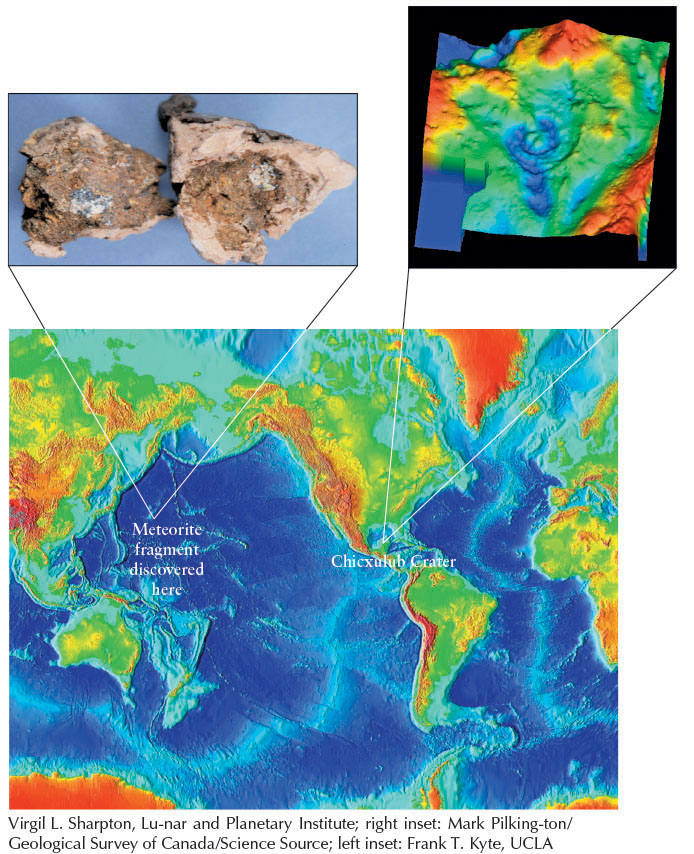
By comparing the chemical composition of the debris at Chicxulub with the chemical composition of meteorites, astronomers and geologists in 2007 determined that the asteroid that caused the mass extinction 65 million years ago came from a group of asteroids called Baptistinas. This group was created as a result of a larger body, some 170 km in diameter, breaking up after a collision 160 million years ago.
Another Impact May Have Led to an Earlier, More Devastating Mass Extinction
The end of the dinosaurs’ reign was not the only mass extinction caused by an impact. In 2001, evidence came to light concerning the Permian-Triassic boundary of 250 million years ago that suggests another devastating blow from space. That time is called the “Great Dying,” a mass extinction during which some 80% of the species of life living on land and 90% of those living in the oceans perished. Rocks from that time discovered in places from Japan to Hungary show evidence, in the form of fullerenes—soccer ball–shaped molecules containing at least 60 carbon atoms—of an impact from space. Trapped inside these fullerenes were gases that could only have been forced into them by exploding stars. (This signature of gas-filled fullerenes from space has now also been discovered in the layer of rock that existed on Earth’s surface 65 million years ago.)
305
A 250-million-year-old crater that may have been the relevant impact site was found in 2004 off the north-western coast of modern-day Australia. Keep in mind that both this impact and the one that ended the reign of the dinosaurs occurred on a world whose surface is in continual motion. Therefore, their present locations are not the same as their initial impact sites. The Chicxulub impact actually occurred in the Pacific Ocean, whereas the Australian impact occurred before the continents were separated from Pangaea (see Section 6-2). The impact explanation of the Great Dying is not universally accepted. Another possible explanation is a massive amount of volcanic eruption that darkened the skies and changed the climate.
Margin Question 9-11
Question
How did the Chicxulub Crater move from the Pacific to the Caribbean?
Could a catastrophic impact happen again? So many asteroids cross Earth’s path that scientists agree that it is a matter of “when” rather than “if.” NASA and other agencies are actively cataloging potentially dangerous asteroids. The good news is that studies of craters show that larger asteroids strike Earth significantly less often than do smaller ones. Although asteroids large enough to create Meteor Crater strike Earth about once every 10,000 years, killer asteroids, like the one that killed off the dinosaurs, collide with Earth only once every 100 million years. The threat of a catastrophic impact by an asteroid or comet in our lifetimes, thankfully, is remote.
9-14 Frontiers yet to be discovered
The years of the Pioneer and Voyager spacecraft were the first golden era of solar system research. We are now in another such period, with spacecraft either in development or already en route to planets, asteroids, comets, and even, as we will see shortly, out observing the weather in space. From studies of solar system debris, astronomers hope to learn whether life on Earth was brought here from elsewhere by asteroid or meteoroid impacts. They also hope to answer such questions as the evolutionary history of the space debris; how much of Earth’s water came here during the planet’s formation and how much landed afterward from comet impacts; whether the asteroids have sufficiently valuable compositions to justify mining them; whether comets can be harvested to supply water and other materials for people colonizing the solar system; and whether the Oort cloud really exists.
306